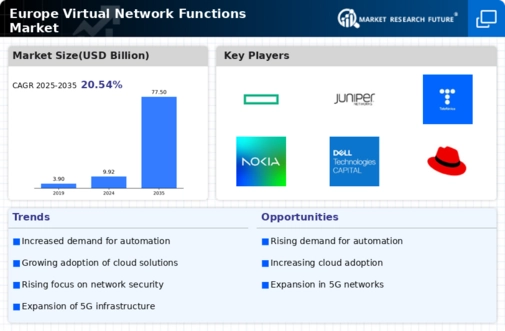Germany : Strong Infrastructure and Innovation Hub
Germany holds a commanding 3.5% market share in the virtual network-functions sector, driven by robust industrial growth and significant investments in digital infrastructure. Key growth drivers include the increasing demand for cloud services, government initiatives promoting digital transformation, and a strong regulatory framework supporting innovation. The country is witnessing a surge in consumption patterns favoring virtualization and automation, particularly in telecommunications and IT sectors.
UK : Innovation and Investment at Forefront
The UK boasts a 2.8% market share in the virtual network-functions market, fueled by a vibrant tech ecosystem and substantial investments in 5G infrastructure. Demand trends indicate a shift towards cloud-native solutions, driven by enterprises seeking agility and cost efficiency. Regulatory support from Ofcom and government initiatives like the Digital Strategy are pivotal in fostering a conducive environment for growth, enhancing the overall digital landscape.
France : Strong Government Support and Growth
France captures a 2.2% market share in the virtual network-functions market, bolstered by government initiatives like the France 2030 plan, which emphasizes digital innovation. Key growth drivers include the rising adoption of IoT and AI technologies, alongside a favorable regulatory environment. The demand for enhanced connectivity and digital services is reshaping consumption patterns, particularly in urban areas.
Russia : Regulatory Landscape and Growth Potential
Russia holds a 1.5% market share in the virtual network-functions market, characterized by a complex regulatory environment and significant state involvement. Key growth drivers include the push for digital sovereignty and local technology development. Demand trends are influenced by government initiatives aimed at enhancing cybersecurity and telecommunications infrastructure, particularly in major cities like Moscow and St. Petersburg.
Italy : Infrastructure Development and Innovation
Italy's market share stands at 1.0% in the virtual network-functions sector, driven by increasing investments in digital infrastructure and a growing emphasis on smart city initiatives. Key growth drivers include the demand for enhanced connectivity and government support for digital innovation. Consumption patterns are shifting towards cloud-based solutions, particularly in sectors like manufacturing and logistics.
Spain : Investment in Connectivity and Innovation
Spain captures a 0.91% market share in the virtual network-functions market, with a focus on enhancing digital infrastructure and connectivity. Key growth drivers include government initiatives aimed at promoting digitalization and the increasing adoption of cloud services. Demand trends reflect a growing interest in virtualization across various sectors, particularly in urban centers like Madrid and Barcelona.
Rest of Europe : Potential for Expansion and Innovation
The Rest of Europe currently holds a 0.0% market share in the virtual network-functions market, indicating untapped potential across various countries. Growth drivers vary significantly, influenced by local regulatory frameworks and market maturity. Demand trends are emerging, particularly in Eastern European nations, where digital transformation initiatives are gaining momentum, supported by EU funding and investment.

















Leave a Comment